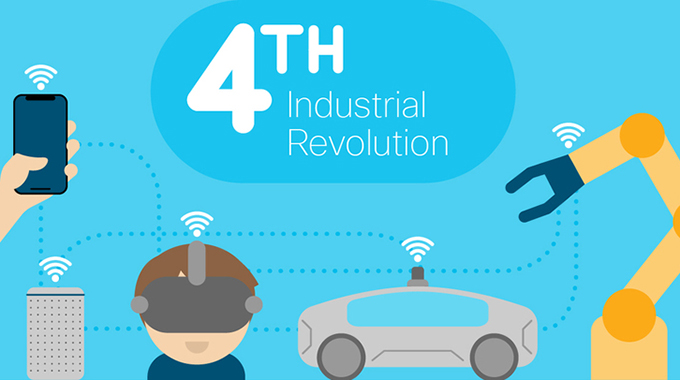Fourth Industrial Revolution: Zim shouldn’t be left out

Lovemore Chikova Assistant Editor
Zimbabwe has no choice but to innovate if its vision of industrialisation and modernisation is to be achieved within the envisaged period.
Although industrialisation and modernisation is a process that sometimes takes long to attain, it can be achieved in a fairly short period with the right ingredients in place.
The first crucial step is for everyone to acknowledge where the country stands at the moment with regards to industrialisation and modernisation.
The reality facing Zimbabwe is that it is far behind when it comes to industrialisation and modernisation, and is still trying to find its feet in that area.
Other countries that have travelled the road which Zimbabwe wants to go started by being frank on where they stood and what was required for them to come out of their situations.
Acknowledging the situation, despite how bad it might be, leads to people brainstorming on the possible solutions and the right path to take towards industrialisation and modernisation.
What is important for Zimbabwe is that such a debate has started, especially after the New Dispensation led by President Mnangagwa came into being in November 2017.
Politicians, businesspeople, churches, students and even the media, have been pre-occupied with trying to chart the way forward on what exactly needs to be done.
The fact which seems to have dawned on everyone is that the country cannot continue lagging behind and needs to catch up with others when it comes to development.
Many forums have been held towards achieving the goals of industrialisation and modernisation, and these have been frank on what exactly needs to be done.
It can thus be safely argued that the country has already passed the first stages of acknowledging the plight it is facing.
What needs to be done is now clear, and the implementation of some of the measures to bring industrialisation and modernisation has already started.
Among the actions to be taken, innovation should be one of the top priorities.
In line with innovation, there is also need for the country not to be left out by the Fourth Industrial Revolution that has taken the world by storm.
Developing countries that have managed to score some progress in their industrialisation processes started with encouraging technological innovation. Many of these are among the so-called Asian Tigers , the likes of China, Singapore, Japan and South Korea.
It is the emphasis on catching up with technology that drove the development that took place in such countries, and this provides huge lessons to fellow developing countries.
Just like the Asian Tigers’ economies in their infancy crying out for technological innovation, the Zimbabwean economy is crying much louder for such progress for it to compete on the global scale.
Traditional methods of doing business are no longer sustainable in sectors such as agriculture, manufacturing and the services industry.
This is the time to invest in technologies that facilitate the ease of doing business to ensure that production is done perfectly and within set times. The establishment of innovation hubs at various universities by the Ministry of Higher and Tertiary Education, Innovation, Science and Technology development should be first step in achieving innovative ways of doing business in various sectors.
It is imperative that the young students going through these innovation hubs come up with a new thinking with regards to how business can be made easier and efficient.
What needs to be drilled into these students’ minds is that while they think the country can borrow technologies from other countries, it is imperative that local innovations anchor such a development. Such innovation capacity cannot, of course, be achieved overnight, but it is imperative that those involved start adjusting to the realities they face in this modern world.
But it all starts with a new mindset , let those responsible in both the public sector and the private sector be flexible enough to allow creativity and the application of innovative ideas.
This is why it is important for the country not to be left out of the Fourth Industrial Revolution, which has been the anchor of modern industrialisation for many countries.
The evolution of the Fourth Industrial Revolution is anchored in the other industrial revolutions that took the world by storm in the past.
These are the First Industrial Revolution, the Second Industrial Revolution and the Third Industrial Revolution.
The First Industrial Revolution defined the beginning of mechanisation in which industrialists used water and steam power to enhance their production.
After that came the Second Industrial Revolution, which instead of relying on water and steam power, the industrialists used electric energy for mass production of goods, as the machines were moving faster.
The Third Industrial Revolution involved the use of automation through electronics and information technology to enhance mass production.
Now, the Fourth Industrial Revolution is characterised by the blending of several technologies at a much faster speed than ever anticipated.
Some have insinuated that this industrial revolution has caught the world by surprise and has not been anticipated.
This technological advance has already shown its characteristics of disrupting the usual way of doing things, ushering in high speed technologies that have changed the world view.
Numerous breakthroughs are being simultaneously made in technological advances, which no other epoch has achieved in the industrialisation process. This means a drastic change in the systems of industrial production.
Such technologies are in the fields of artificial intelligence, robotics, 3-D printing energy storage, quantum computing and biotechnology, and they anchor the new industrial revolution.
All these technologies are fast changing the way people live and how they conduct business, relate to each other and how they produce goods and services.
It is a fact that the Fourth Industrial Revolution is bringing huge developmental potential to developing countries, with those who can access the new technologies being able to acquire goods and services that enhance the quality of life.
This new revolution will help enhance the ease of doing business, with people easily accessing information, goods and services.
Just giving an example of the advanced smartphone which has already changed the way people do business, shows why any country with developmental aspirations should not be left out.
Today, one can use the smartphone to buy goods and services from anywhere in the world, a situation that was unthinkable a few years ago.
For Zimbabwe, what is needed is a cooperation between the innovation hubs cited above and industrialists so that innovative ideas can be transformed into usable products.
There are a lot of inventions that have ended as experiments or ideas in the local universities because industry has not absorbed them.
A few that have been taken board have worked wonders in making it easy for transactions to take place.
The Harare Institute of Technology has produced the Enterprise Resource Planning (ERP) software that is being used by many rural district councils in the country to aid the flow of their business and allow easy communication among departments.
The same institution has also come up with the Tap and Go application that is being used by the Zimbabwe United Passenger Company as a pre-payment system for bus fare.
This shows that with much focus and more planning, Zimbabwe can easily innovate its way around the Fourth Industrial Revolution, and easily catch up with other countries in its developmental agenda.









Comments